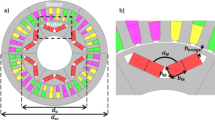Abstract
An external rotor permanent magnet synchronous generator (ERPMSG) model for Range-Extended Electric Vehicles is developed. The temperature field simulation model of the ERPMSG is established. Experimental test of the winding temperature shows that the simulation model is believable and then it is used to optimize the structural parameters of the cooling water channel. It is found that the pressure loss increases with the number of layers of the cooling water channel increasing and the width of the water channel decreasing. In order to obtain a large turbulent effect and a minimum pressure loss simultaneously, the number of layers of the cooling water channel is set to be 3 and the width of the waterway 8 mm. The corner of the water channel is designed round with an optimum radius of 20 mm. After optimization, the cooling performance of the ERPMSG is obviously improved. Compared with the ERPMSG before optimization, the temperature of the ERPMSG with optimum structure parameters of the cooling water channel is lower. The maximum temperatures of the winding, the stator core and the rotor of the ERPMSG with optimum structure parameters of the cooling water channel decrease 8.19 °C, 5 °C and 7.42 °C respectively. Temperature distribution is more uniform in the permanent magnet of the ERPMSM with waterway structure optimization.












Similar content being viewed by others
References
Lovelace EC, Jahns TM, Keim TA, Lang JH (2004) Mechanical design considerations for conventionally laminated, high-speed, interior PM synchronous machine rotors. IEEE Trans Ind Appl 40(3):806–812
Wang JQ, Wang FX, Bao WB, Guan EL (2005) Rotor design and strength analysis of high speed permanent magnet machine. Proc CSEE 25(15):140–144
Zhou GX, Tang RY, Lee DH, Ahn JW (2008) Field circuit coupling optimization design of the main electromagnetic parameters of permanent magnet synchronous motor. J Electr Eng Technol 3(1):88–93
Barcaro M, Meneghetti G, Bianchi N (2014) Structural analysis of the interior PM rotor considering both static and fatigue loading. IEEE Trans Ind Appl 50(1):253–260
Borisavljevic A, Polinder H, Ferreira JA (2010) On the speed limits of permanent-magnet machines. IEEE Trans Ind Electron 57(1):220–227
Yon JM, Mellor PH, Wrobel R, Booker JD, Burrow SG (2012) Analysis of semipermeable containment sleeve technology for high-speed permanent magnet machines. IEEE Trans Energy Convers 27(3):646–653
Li W, Qiu H, Zhang X, Cao J, Zhang S, Ran Y (2013) Influence of rotor-sleeve electromagnetic characteristics on high-speed permanent-magnet generator. IEEE Trans Ind Electron 61(6):3030–3037
Li W, Qiu H, Zhang X, Cao J, Ran Y (2013) Analyses on electromagnetic and temperature fields of superhigh-speed permanent-magnet generator with different sleeve materials. IEEE Trans Ind Electron 61(6):3056–3063
Zhou F, Shen J, Fei W, Lin R (2006) Study of retaining sleeve and conductive shield and their influence on rotor loss in high-speed PM BLDC motors. IEEE Trans Magn 42(10):3398–3400
Xiao JC, Xiao SH, Wu H (2011) Design and strength analysis of ultra-high speed permanent magnet DC rotor. Adv Mater Res 188(1):481–486
Hong D, Woo B, Lee J, Koo D (2012) Ultra high speed motor supported by air foil bearings for air blower cooling fuel cells. IEEE Trans Magn 48(2):871–874
Li Z, Zhan Y (2016) Rotor strength analysis of high speed permanent magnet machine. J Mech Electr Eng 33(7):900–903
Fang H, Ronghai Q, Li J, Zheng P, Fan X (2017) Rotor design for high-speed high-power permanent-magnet synchronous machines. IEEE Trans Ind Appl 53(7):3411–3419
Li W, Qiu H, Zhang X, Cao J, Yi R (2014) Analyses on electromagnetic and temperature fields of superhigh-speed permanent-magnet generator with different sleeve materials. IEEE Tran Ind Electron 61(6):3056–3063
Uzhegov N, Kurvinen E, Nerg J, Pyrhönen J, Sopanen JT, Shirinskii S (2016) Multidisciplinary design process of a 6-slot 2-pole high-speed permanent-magnet synchronous machine. IEEE Trans Ind Electron 63(2):784–795
Bazzo TD, Kölzer JF, Carlson R, Wurtz F, Gerbaud L (2017) Multiphysics design optimization of a permanent magnet synchronous generator. IEEE Trans Ind Electron 64(12):9815–9823
Yin H (2015) Loss calculation and temperature field analysis of permanent magnet synchronous motor. Harbin Institute of Technology, Harbin
Bao L, Wei S, Qiu J (1985) Aerodynamics and heat transfer in motor. Machinery Industry Press, Beijing
Jiang S (2010) Loss analysis and temperature field calculation of high speed permanent magnet synchronous motor. Harbin Institute of Technology, Harbin
Fu Y (2014) Temperature field analysis of permanent magnet synchronous motor for electric car. Liaoning University of Technology, Jinzhou
Acknowledgements
This work is supported by the National Natural Science Foundation of China (No. 51375176), Research and Development Program in Key Areas of Guangdong Province (No. 2019B090914001), Foshan science and technology innovation project (No. 2016AG101773).
Author information
Authors and Affiliations
Corresponding author
Additional information
Publisher’s note
Springer Nature remains neutral with regard to jurisdictional claims in published maps and institutional affiliations.
Rights and permissions
About this article
Cite this article
Wan, Z., Sun, B., Wang, X. et al. Waterway design of an external rotor permanent magnet synchronous generator. Heat Mass Transfer 56, 1249–1261 (2020). https://doi.org/10.1007/s00231-019-02762-3
Received:
Accepted:
Published:
Issue Date:
DOI: https://doi.org/10.1007/s00231-019-02762-3




